The textile industry is one of the most resource-intensive and pollution-generating sectors globally. In Singapore, where sustainability and environmental protection are key pillars of industrial policy, efficient wastewater treatment in the textile sector is essential. Among the various chemical agents used, Calcium Hypochlorite (Ca(ClO)₂) has emerged as a reliable and effective oxidizing agent in managing and treating textile effluents.
This article explores the chemical properties, mechanisms of action, applications, and challenges associated with calcium hypochlorite in the context of Singapore’s environmentally conscious and innovation-driven industrial ecosystem.
What is Calcium Hypochlorite?
Calcium hypochlorite is a white or greyish-white granular solid, commonly used as a disinfectant and oxidizer. It is commercially available in powder or tablet form and contains approximately 65–70% available chlorine.
Key properties include:
In wastewater treatment, these characteristics make calcium hypochlorite particularly valuable for decolorization, disinfection, and breakdown of organic contaminants.
Challenges in Textile Wastewater Treatment
Textile effluent is a complex mixture containing:
-
Synthetic dyes (azo, anthraquinone, etc.)
-
Heavy metals
-
Detergents, surfactants, and softeners
-
High COD (Chemical Oxygen Demand) and BOD (Biochemical Oxygen Demand)
These pollutants pose severe risks to the environment and public health if untreated. In Singapore, regulatory frameworks like the Environmental Protection and Management Act (EPMA) enforce strict discharge standards for industrial effluents.
Mechanism of Action: How Calcium Hypochlorite Works
-
Oxidation of Organic Compounds
Calcium hypochlorite breaks down complex organic molecules through oxidation, converting them into simpler and less harmful forms like CO₂ and H₂O.
-
Decolorization of Dyes
Reactive and direct dyes used in textiles often resist biodegradation. Calcium hypochlorite disrupts the chromophoric groups (such as azo bonds), leading to effective color removal.
-
Disinfection
The hypochlorous acid (HOCl) generated when calcium hypochlorite dissolves in water is a powerful antimicrobial agent that eliminates bacteria, fungi, and viruses, improving overall effluent quality.
-
Precipitation of Heavy Metals
Chlorine oxidation facilitates the transformation of some metal ions to less soluble forms, allowing them to be separated by sedimentation or filtration.
Applications in Singapore’s Textile Industry
-
Pre-treatment of Effluent
Before biological or physical-chemical treatment stages, calcium hypochlorite is used to:
-
Color Removal Systems
Color pollution is a significant concern, especially in Singapore’s urban environment where even trace levels can affect water aesthetics. Calcium hypochlorite-based oxidation tanks or batch treatment systems are integrated to break down persistent dyes efficiently.
-
Final Polishing Stage
After primary treatment, calcium hypochlorite can be dosed in the final stage to:
Advantages of Using Calcium Hypochlorite
-
High Efficiency: Effective even at low concentrations.
-
Storage Stability: Longer shelf life compared to sodium hypochlorite.
-
Compact Handling: Easier to transport and dose in granular form.
-
Wide-spectrum Disinfection: Works against a broad range of microbes.
-
Synergistic Effects: Can be combined with other oxidants or coagulants.
Limitations and Considerations
-
Chlorinated By products
Excess dosing may lead to the formation of trihalomethanes (THMs) or chlorinated organics, which are regulated due to toxicity. Careful control of dosage and reaction time is required.
-
Corrosiveness
Calcium hypochlorite is corrosive to metals and requires proper handling using PVC or HDPE equipment.
-
Worker Safety
As an oxidizer, it must be stored in cool, dry, and well-ventilated areas to prevent fire hazards. Personal protective equipment (PPE) is essential during handling.
Integration with Other Treatment Methods
In Singapore, integrated wastewater treatment systems are commonly used. Calcium hypochlorite can be effectively combined with:
-
Coagulation-flocculation (e.g., alum or PAC)
-
Membrane filtration systems
-
Biological treatment (e.g., MBRs)
-
Advanced oxidation processes (AOPs) like UV/H₂O₂
This synergy improves treatment outcomes while optimizing operational costs and meeting sustainability targets.
Case Study: Textile Plant in Jurong Industrial Estate
A mid-sized textile dyeing facility in Jurong Industrial Estate implemented a chemical oxidation unit using calcium hypochlorite before its biological treatment stage. The results included:
The plant also reduced penalties for effluent non-compliance and reported better membrane filter performance downstream due to lower organic fouling.
Environmental and Regulatory Compliance in Singapore
Singapore's National Environment Agency (NEA) imposes strict regulations on:
Using calcium hypochlorite helps textile companies stay compliant with:
This avoids costly fines and enhances a company’s environmental reputation.
Sustainable Practices and Future Outlook
-
Recovery and Recycling New technologies allow for recovery of partially oxidized wastewater, reducing the overall freshwater footprint of textile operations.
-
Smart Dosing Systems IoT-based systems in Singapore now enable real-time monitoring and automated dosing, optimizing calcium hypochlorite usage and minimizing waste.
-
Green Alternatives and Hybrid Models Though calcium hypochlorite is effective, research is also exploring combinations with enzyme-based treatments, electrochemical oxidation, and zero-liquid discharge (ZLD) strategies for greater sustainability.
Conclusion
Calcium hypochlorite remains a core chemical agent in the fight against industrial water pollution particularly in Singapore’s textile industry. Its powerful oxidizing properties, ease of use, and compatibility with existing treatment systems make it a versatile solution for addressing color, pathogens, and organic load in textile effluents.
As Singapore continues its commitment to sustainable industrial practices, the use of calcium hypochlorite when combined with modern control technologies and integrated treatment systems will continue to support cleaner waterways and greener production processes. If you are interested in our products for your specific business needs, please do not hesitate to contact us.


Leave a Comment